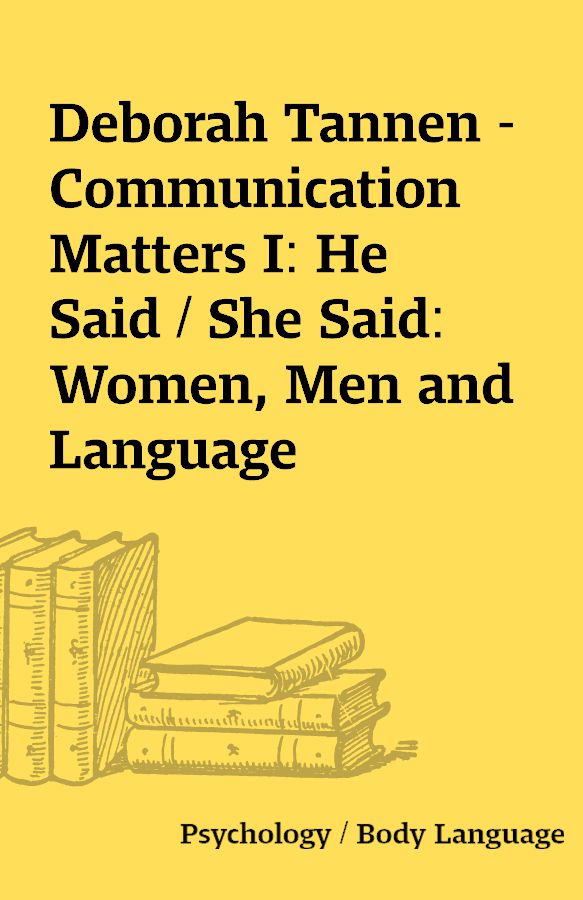Deborah Tannen – Communication Matters I: He Said / She Said: Women, Men and Language
Deborah Tannen – Communication Matters I
[CDs – MP3 and GuideBook – OCR JPGs]
Description
Communication Matters I: He Said / She Said: Women, Men and LanguageCourse SyllabusLecture 1 He Said/She Said: A framework for Understanding Conversations Between Women and Men Lecture 2 The Source of Gender Patterns: Children at PlayLecture 3 A Cross-Cultural Approach to GenderTalk Lecture 4 The Role of Opposition in Men’s Relationships Lecture 5 The Role of Talk in Women’s Relationships Lecture 6 The Interplay of Power and Connection Lecture 7 Ambiguity and Polysemy: Two Keys to Understanding Language and Gender Lecture 8 Indirectness: Not in So Many Words Lecture 9 Talking at Home: Gender in the Family Lecture 10 Talking at Work Lecture 11 Who Talks More?: Public and Private Speaking Lecture 12 A History of Research on Gender and Language Lecture 13 Nature/Nurture: The Source of Gender Differences Lecture 14 Conclusion: What Can You Do? [Comes with colour OCR scan of Guide Book in JPG format (40 .jpg files).Guide Book has many photos.] When I wrote You Just Don’t Understand: Women and Men in Conversation I didn’t know that what everyone would respond to most strongly is the question, “Why don’t men like to stop and ask for directions?” (Before the book was published, no one talked about this gender difference; as a result of the book, it is now the ubiquitous subject of jokes, cartoons, skits, greeting cards, and casual conversations.) The answer to this question will be revealed in the lectures that follow, as it captures the essence of what this course will address: the patterns that tend to distinguish how men and women use language in their everyday lives, and the consequences of these differences (as well as similarities) for conversations and relationships between women and men.My goal in this series, in addition to illuminating the patterns of women’s and men’s uses of language, is to enhance understanding of how language works in everyday life. I am told by students who have taken my courses that this understanding helps them in their everyday lives, as every aspect of our lives involves talking to people of the other sex—in our personal relationships, our families, at work, and in trying to get just about anything done.My research on cross-gender communication grew out of my linguistic research on how people use language in conversation. I was invited to take part in a research project organized by a psychologist, Bruce Dorval, that was funded by the Social Science Research Council. We examined videotapes of children talking to their best friends across a range of ages. In looking at Dorval’s videotapes, I noticed a pattern of physical orientation: At every age, girls and women sat face to face and looked directly at each other when they talked, whereas boys and men sat at angles, or parallel, and looked around the room. Seeing this pattern span such a range of ages is what prompted me to think of cross-gender communication as cross-cultural.Throughout this course, I will be developing this metaphor, drawing on my own original research as well as research by others in the fields of linguistics, anthropology, sociology, education, and psychology. Some of the topics I will explore in these lectures include: Who talks more, men or women? Who interrupts more, women or men? What do women and men tend to talk about? Who is more “indirect” in saying what we mean? Why would anyone be indirect in saying what we mean? Where do these differences come from; how early do they start? In answering all these and many other questions, I will describe and exemplify patterns in the ways women and men tend to use language in our everyday lives. I’ll trace these patterns to the way boys and girls use language growing up, and explore, in some detail, the process by which humans express meaning, accomplish tasks, and form and manage relationships through language. —Dr. Deborah Tannen Professor Deborah Tannen (Georgetown University)Deborah Tannen holds the distinguished rank of University Professor at Georgetown University, where she has been on the faculty of the linguistics department since 1979. Her book You Just Don’t Understand: Women and Men in Conversation was on The New York Times best-seller list for nearly four years… Have you ever wondered whether the sociological stuff that David DeAngelo and others talk about is really true, and how do we know. Well, when you start listening to this programme, which is conducted by a linguistics expert, you will see how. Studies, studies and more studies. What makes this amazing is that the people doing these studying have absolutely no intention of trying to apply it to PUA. Yet, we can!
You must be logged in to post a review.






Reviews
There are no reviews yet.